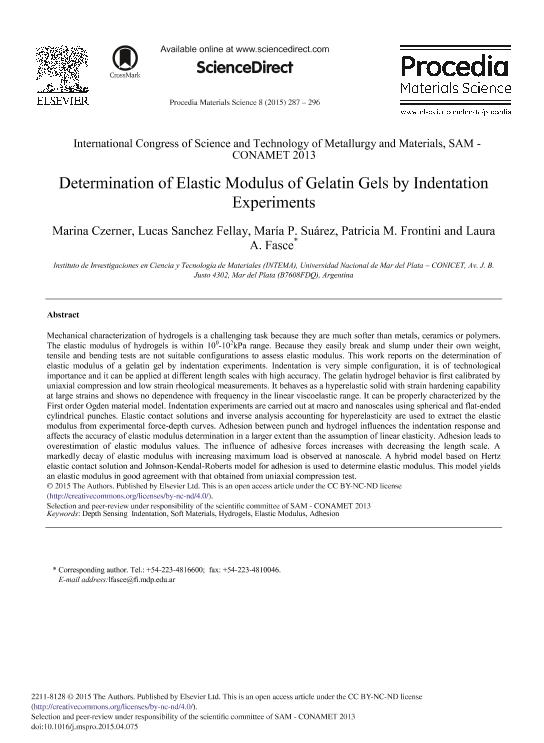Mostrar el registro sencillo del ítem
dc.contributor.author
Czerner, Marina

dc.contributor.author
Sanchez Fellay, Lucas

dc.contributor.author
Suarez, Maria Patricia

dc.contributor.author
Frontini, Patricia Maria

dc.contributor.author
Fasce, Laura Alejandra

dc.date.available
2016-05-27T13:47:23Z
dc.date.issued
2015-07
dc.identifier.citation
Czerner, Marina; Sanchez Fellay, Lucas; Suarez, Maria Patricia; Frontini, Patricia Maria; Fasce, Laura Alejandra; Determination of elastic modulus of gelatin gels by indentation experiments; Elsevier; Procedia Materials Science; 8; 7-2015; 287-296
dc.identifier.issn
2211-8128
dc.identifier.uri
http://hdl.handle.net/11336/5862
dc.description.abstract
Mechanical characterization of hydrogels is a challenging task because they are much softer than metals, ceramics or polymers.The elastic modulus of hydrogels is within 100 -102kPa range. Because they easily break and slump under their own weight,tensile and bending tests are not suitable configurations to assess elastic modulus. This work reports on the determination of elastic modulus of a gelatin gel by indentation experiments. Indentation is very simple configuration, it is of technological importance and it can be applied at different length scales with high accuracy. The gelatin hydrogel behavior is first calibrated byuniaxial compression and low strain rheological measurements. It behaves as a hyperelastic solid with strain hardening capabilityat large strains and shows no dependence with frequency in the linear viscoelastic range. It can be properly characterized by theFirst order Ogden material model. Indentation experiments are carried out at macro and nanoscales using spherical and flat-endedcylindrical punches. Elastic contact solutions and inverse analysis accounting for hyperelasticity are used to extract the elasticmodulus from experimental force-depth curves. Adhesion between punch and hydrogel influences the indentation response andaffects the accuracy of elastic modulus determination in a larger extent than the assumption of linear elasticity. Adhesion leads tooverestimation of elastic modulus values. The influence of adhesive forces increases with decreasing the length scale. A markedly decay of elastic modulus with increasing maximum load is observed at nanoscale. A hybrid model based on Hertz elastic contact solution and Johnson-Kendal-Roberts model for adhesion is used to determine elastic modulus. This model yieldsan elastic modulus in good agreement with that obtained from uniaxial compression test
dc.format
application/pdf
dc.language.iso
eng
dc.publisher
Elsevier

dc.rights
info:eu-repo/semantics/openAccess
dc.rights.uri
https://creativecommons.org/licenses/by-nc-nd/2.5/ar/
dc.subject
Depth Sensing Indentation
dc.subject
Soft Materials
dc.subject
Hydrogels
dc.subject
Elastic Modulus
dc.subject
Adhesion
dc.subject.classification
Recubrimientos y Películas

dc.subject.classification
Ingeniería de los Materiales

dc.subject.classification
INGENIERÍAS Y TECNOLOGÍAS

dc.subject.classification
Bioproductos, Biomateriales, Bioplásticos, Biocombustibles, Bioderivados, etc.

dc.subject.classification
Biotecnología Industrial

dc.subject.classification
INGENIERÍAS Y TECNOLOGÍAS

dc.title
Determination of elastic modulus of gelatin gels by indentation experiments
dc.type
info:eu-repo/semantics/article
dc.type
info:ar-repo/semantics/artículo
dc.type
info:eu-repo/semantics/publishedVersion
dc.date.updated
2016-05-03T14:55:29Z
dc.journal.volume
8
dc.journal.pagination
287-296
dc.journal.pais
Países Bajos

dc.journal.ciudad
Amsterdam
dc.description.fil
Fil: Czerner, Marina. Consejo Nacional de Investigaciones Científicas y Técnicas. Centro Científico Tecnológico Mar del Plata. Instituto de Investigación En Ciencia y Tecnología de Materiales (i); Argentina. Universidad Nacional de Mar del Plata. Facultad de Ingeniería; Argentina
dc.description.fil
Fil: Sanchez Fellay, Lucas. Consejo Nacional de Investigaciones Científicas y Técnicas. Centro Científico Tecnológico Mar del Plata. Instituto de Investigación En Ciencia y Tecnología de Materiales (i); Argentina. Universidad Nacional de Mar del Plata. Facultad de Ingeniería; Argentina
dc.description.fil
Fil: Suarez, Maria Patricia. Consejo Nacional de Investigaciones Científicas y Técnicas. Centro Científico Tecnológico Mar del Plata. Instituto de Investigación En Ciencia y Tecnología de Materiales (i); Argentina. Universidad Nacional de Mar del Plata. Facultad de Ingeniería; Argentina
dc.description.fil
Fil: Frontini, Patricia Maria. Consejo Nacional de Investigaciones Científicas y Técnicas. Centro Científico Tecnológico Mar del Plata. Instituto de Investigación En Ciencia y Tecnología de Materiales (i); Argentina. Universidad Nacional de Mar del Plata. Facultad de Ingeniería; Argentina
dc.description.fil
Fil: Fasce, Laura Alejandra. Consejo Nacional de Investigaciones Científicas y Técnicas. Centro Científico Tecnológico Mar del Plata. Instituto de Investigación En Ciencia y Tecnología de Materiales (i); Argentina. Universidad Nacional de Mar del Plata. Facultad de Ingeniería; Argentina
dc.journal.title
Procedia Materials Science
dc.relation.alternativeid
info:eu-repo/semantics/altIdentifier/url/http://www.sciencedirect.com/science/article/pii/S2211812815000760
dc.relation.alternativeid
info:eu-repo/semantics/altIdentifier/doi/10.1016/j.mspro.2015.04.075
dc.relation.alternativeid
info:eu-repo/semantics/altIdentifier/url/https://doi.org/10.1016/j.mspro.2015.04.075
Archivos asociados
